Compact Sportage makes large impression
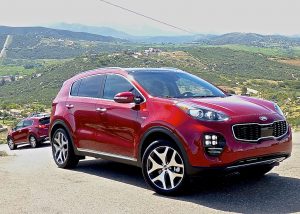
The 2017 Kia Sportage showed its turbocharged flair in the Southern California mountains, but is equally at home on suburban roadways.
By John Gilbert
It’s difficult enough for a car-maker to try to compete in the most intense segment in the industry, but for Kia it’s even more of a challenge, because it had to additionally compete with Hyundai, its South Korean partner and benefactor, before coming out with the 2017 Kia Sportage.
Compact crossover SUVs are currently the rage in automotives, and finally we’ve got a trend that makes sense. If larger or midsize SUVs have more space than cars and can haul everything at once, they also cost more money, require larger engines and therefore suffer when it comes to fuel economy, and they are more difficult to drive in congested traffic, let alone park.
The trend a decade ago to downsize from large SUVs to midsize was, therefore, logical and made economic sense. Whne the trend continued, down from midsize to compact crossover SUVs (CUVs), they proved enormously popular. If the room is adequate, the compacts could boast of much better sticker prices, and sportier handling with smaller, peppier and more fuel-efficient engines.
A perfect example is the 2017 Kia Sportage, the compact little brother to the solidly entrenched midsize Kia Sorento. It is a parallel vehicle to Hyundai’s Tucson, but there are significant differences, leaving both with distinct advantages.
Hyundai took over Kia almost a decade ago, and the two have been raised as separate but equal companies, both benefitting by the other’s successes. Hyundai was on the verge of an engine-making breakthrough right about then, and Kia came along with some equally brilliant design ideas. That helped make it more of a merger than a takeover, and both kept turning out exceptional vehicles from the smallest compact cars up through luxury vehicles, and with SUVs that filled all the required gaps.
During recent new-vehicle introductions by both Hyundai and Kia, I’ve asked executives of both partners if they were concerned about too much similarity in their parallel models. They indeed said that was a concern, adding that steps were being taken to differentiate them.
Their timing couldn’t have been better than with the compact crossover SUV battles. Kia’s Sportage and Hyundai’s Tucson are sophisticated compact crossovers that share the same platform, but they veer off and split when it comes to powertrains, and designs..
The Tucson was new for 2016, and it is a solid, safe vehicle, powered by either a 2.0-liter 4-cylinder, or a newly turbocharged 1.6-liter 4 that is smaller in displacement but bigger in horsepower and torque than the normally-aspirated 2.0.
Kia allowed the Tucson its time in the spotlight, and for 2017, the all-new redesigned Sportage hits the marketplace with distinctive differences in purpose. Where the Tucson is mainstream/family oriented, the Sportage is built to look and be sportier.
The Sportage uses the larger 2.4-liter engine with 181 horsepower and 175 foot-pounds of torque for snappy everyday use in the basic Sportage. But moving up to the sportiest SX model, it turbocharges the corporate 2.0-liter 4-cylinder, boosting its horsepower to a neck-snapping 240, with 260 foot-pounds of torque — up nearly 80 horses and 90 foot-pounds above the normally-aspirated 2.0.
At the introduction of the new Sportage, we drove various models up into the California hills, east of San Diego using mostly the front-wheel-drive models. I stressed that anyone in Duluth, Minnesota, buying an SUV of large, medium, compact, or small, could survive with front-drive, but all-wheel drive was only a logical improvement. My pleas didn’t get me any more time in the AWD version at the introductory drive, but Kia came through by sending a Sportage SX out of its Chicago press fleet for me to use for a week to challenge the Duluth hillsides.
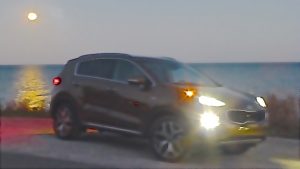
A full moon, enlarged by close proximity to Earth, had its brightness augmented by the Sportage light show.
It was no challenge. My favorite part of the week was in mid-November when the moon was closer to the Earth than at any time in the past 68 years, so we drove down to the North Short of Lake Superio to watch the enlarged moon rise.
The 6-speed automatic transmission worked well, particularly with the steering-wheel paddles that add to the sporty flair of the Sportage. Paddle to click up through the gears manually make it more fun to run the revs up, but it’s even more beneficial to be able to manually use the paddles to downshift, maybe going from sixth down to third for descending from those hills without riding the brake pedal.
The test Sportage SX Turbo was loaded, with the giant panoramic sunroof and all-wheel drive, plus the turbocharged 2.0 engine. It has a base price of $34,000, while other base prices, in descending order, are $32,500 for the same engine in front-wheel drive; $27,000 for the EX model with AWD; or $25,500 for the EX with the 2.4 and front-wheel drive; the LX starts at $24,490 for the 2.4 with AWD, or a mere $22,990 for the 2.4 FWD.
All the new Sportage models come with much steering and handling improved significantly to tackle twisty curves or normal driving. I attributed the more solid and secure stance to the all-wheel drive system, although similar accolades should go to the stiffer platform’s 39 percent improvement in rigidity because of greatly increased use of high-strength steel.
The current Sportage is the third generation, and it came out in 2011. It was stylish enough to continue selling well, but every other Kia vehicle has been redesigned since then. With a storeroom full of high-tech advancements in the same time, the Sportage was able to gain from that parts bin.
New features include a 320-watt, 8-speaker Harmon Kardon sound system, the latest smartphone apps and other creature features are impressive, but so are driving aids such as automatic braking, radar-based side, rear and cross-traffic alerts, lane departure warning, lane change assist, front and rear parking assist, and autonomous braking. When the car detects a pedestrian and the driver doesn’t, it stops and you’re thankful.
Seats have been improved, and the wide, sweeping design of the dashboard is appealing to look at, and it’s covered in soft-padded leather-like stuff.
My wife, Joan, got her hands on the Sportage SX turbo AWD a few times, and her favorite feature, after the startling quickness of the turbo acceleration was: “But most of all, I like the automatic headlights,” she said.
In the Sportage, as in some very expensive vehicles, you turn the headlight knob to “auto,” and it somehow knows exactly when to dim your high beams as another car approaches, and it instantly flicks them back up to high as soon as it is out of view.
Slightly enlarged, a width of 73 inches, and 1.6-inch length and 1.2-inch wheelbase increases help create more interior room. The clean redesign of the dashboard and seating area are topped with an enlarged sunroof. If you have the key-fob in your possession, you can stand behind the rear of the Sportage for 3 seconds, and the tailgate will open itself electronically. With all of that, the Sportage is 65 pounds lighter because of industrial strength adhesives and all the high-strength steel, which is lighter but stronger than normal steel.
The Dynamax all-wheel-drive system is borrowed from the Sorento, and it electronically simulates driving input to virtually predict any potential loss of traction, making it far more effective than systems that simply react to a loss of traction. It can adjust up to 100 percent of engine torque to either front or rear, when it detects slipping, and in normal circumstances it rides around as a front-driver. It also provides 2,000 pounds of towing, which is a lot for a compact SUV.
Design-wise, the Sportage stands out from other SUVs of any size. The signature grille is there, which is something like a horizontal oval that has been squished down in the middle. It works on the Optima sedan, and the compact cousins, the Forte and the hamster-loving Soul, plus the Rio sub-compact, and the newer luxury sedans like the Cadenza and the K-900. Also, all the truck varieties, from the Sedona van to SUVs like the Sorento and now the Sportage share the Kia grille.
The main difference is in its silhouette, where the Sportage has a squared off rear roofline with a wide pillar. It has a more steeply raked windshield, and the stylish roofline is squared off where all others seem to reach for swoopy lines and curves at the rear pillar. You could complain that the squared off rear roofline inhibits visibility to the rear, but I didn’t notice it while driving.
Best remembered after driving the Sportage SX is the sporty behavior, starting in front-wheel-drive Sportage models without the extra weight of all-wheel drive. And I’m sure, with proper tires, the FWD would be adequate to get you through a Minnesota winter or six. For me, though, the potency of the turbo engine with all-wheel drive makes it a no-brainer to make all four wheels work, even if it drops fuel economy down toward the 20-23 range.
Of course, the age-old fuel economy vs. performance duel enhances the competition with Hyundai. You could get the slightly less-sporty Tucson and gain a half-dozen miles per gallon, up toward 28 or 30 on the highway, or you could accept 20-23 with the Sportage SX, pay a tad more for fuel, and have all that fun with the hot turbo.


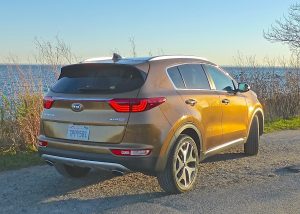
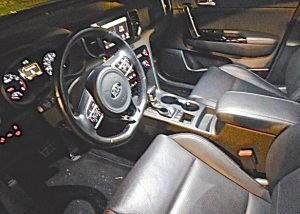
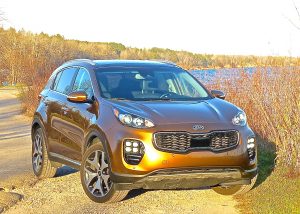
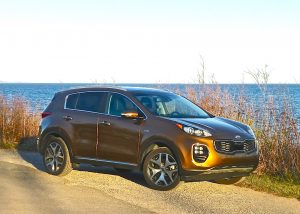
 John Gilbert is a lifetime Minnesotan and career journalist, specializing in cars and sports during and since spending 30 years at the Minneapolis Tribune, now the Star Tribune. More recently, he has continued translating the high-tech world of autos and sharing his passionate insights as a freelance writer/photographer/broadcaster. A member of the prestigious North American Car and Truck of the Year jury since 1993. John can be heard Monday-Friday from 9-11am on 610 KDAL(www.kdal610.com) on the "John Gilbert Show," and writes a column in the Duluth Reader.
John Gilbert is a lifetime Minnesotan and career journalist, specializing in cars and sports during and since spending 30 years at the Minneapolis Tribune, now the Star Tribune. More recently, he has continued translating the high-tech world of autos and sharing his passionate insights as a freelance writer/photographer/broadcaster. A member of the prestigious North American Car and Truck of the Year jury since 1993. John can be heard Monday-Friday from 9-11am on 610 KDAL(www.kdal610.com) on the "John Gilbert Show," and writes a column in the Duluth Reader.